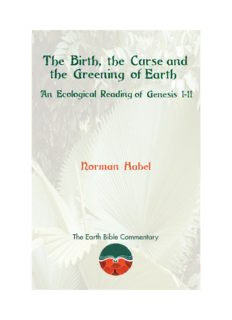
The Birth, the Curse and the Greening of Earth: An Ecological Reading of Genesis 1-11 PDF
Preview The Birth, the Curse and the Greening of Earth: An Ecological Reading of Genesis 1-11
T B , C G e he irTh The urse and The reeninG of arTh The Earth Bible Commentary Series, 1 Series Editor Norman Habel Editorial Board Vicky Balabanski, Hilary Marlow, Barbara Rossing, Peter Trudinger, Elaine Wainwright, Joh Wurst Dedicated to Wilhelm Gottfried Habel my great grandfather, an early environmentalist on a farm in Victoria, Australia, in the 19th century. T B , C he irTh The urse and The G e reeninG of arTh an eColoGiCal readinG of Genesis 1–11 Norman Habel sheffield Phoenix Press 2011 Copyright © 2011 Sheffield Phoenix Press Published by Sheffield Phoenix Press Department of Biblical Studies, University of Sheffield, 45 Victoria Street, Sheffield S3 7QB UK www.sheffieldphoenix.com All rights reserved. No part of this publication may be reproduced or transmitted in any form or by any means, electronic or mechanical, including photocopying, recording or any information storage or retrieval system, without the publishers’ permission in writing. A CIP catalogue record for this book is available from the British Library Typeset by ISB Typesetting Printed on acid-free paper by Lightning Source UK Ltd, Milton Keynes ISBN 978-1-907534-19-5 (hardback) C ontents Terminology vii Preface ix Abbreviations xi Chapter 1 IntroduCIng The earTh BiBle CommenTary serIes 1 Chapter 2 IntroduCIng genesIs 1–11 17 Chapter 3 genesIs 1.1–2.4a: the orIgIn Myth of ereTs and shemayim 24 Chapter 4 genesIs 24b–3.24: the orIgIn Myth of adamah and adam 46 Chapter 5 genesIs 4.1-26: the Myth of adamah, CaIn, and abel 67 Chapter 6 genesIs 5.1–6.4: the fIrst InhabItants of adamah 77 Chapter 7 genesIs 6.5-13: ratIonales for destroyIng adamah and ereTs 83 Chapter 8 genesIs 6.14–8.19: the Catastrophe Myths of adamah and ereTs 90 Chapter 9 genesIs 8.19–9.29: post-flood Changes In adamah and ereTs 103 Chapter 10 genesIs 10–11: ereTs after the flood 115 Appendices the ereTs, adamah and Tselem Myths 130 Bibliography 136 t erMInology Adam—the human/human being, derived from Adamah, as distinct from Adam, the name given to the first human in the Genesis genealogies Adamah—the fertile ground; the central domain/character in the Adamah myth Adamah myth—a sequence or cycle of origin stories set in the primordial in which Adamah is the central domain/character basar—flesh; the term for all life in the Erets myth Elohim—God and the name of God used in the Erets myth Erets—Earth, as distinct from sky (shamayim); the central domain/character in the Erets myth Erets myth—a sequence or cycle of origin stories set in the primordial in which Erets is the central domain/character Yhwh—the four consonants designating the name of Israel’s God; the name for God in the Adamah myth shamayim—sky, as distinct from heaven; the domain/character in the Erets myth from which Erets is separated toledoth—generations; the designation used as a framing device for the collected myths and legends in Genesis 1–11 tselem—image, concrete replica; a central symbol in the Tselem myth Tselem myth—a sequence of origin stories, some only fragments, set in the primordial in which tselem is the central symbol Note on transliteration: where Adam, Adamah, and Erets function as central figures in a given myth, the silent aleph at the beginning of the word is deleted to facilitate reading; the definite article is also omitted to highlight that these figures are characters/domains of the myth rather than background scenery. p refaCe In 1964 I wrote my first major paper on Genesis 2–3 for an assembly of the Lutheran hierarchy in St Louis. I was accused of heresy by some for daring to suggest that this Genesis narrative may be ‘more than history’. Over the years, I have applied a wide range of critical approaches to Genesis 1–11. In this volume, I am suggesting that if we read Genesis employing an ecological hermeneutics, we discover new dimensions of meaning. Of course, Genesis 1–11 embraces several myths. Perhaps today, as we read with ecological eyes, we may say that these texts are ‘more than myth’: they are also profound stories in which we may hear Earth telling her story and voicing her indictments regarding our treatment of our environment. The volumes in the Earth Bible Commentary series are the natural exten sion of The Earth Bible series published in 2000–2002. I wish to thank David Clines and Sheffield Phoenix Press for resurrecting this series—it has already made a significant contribution to biblical hermeneutics. I also wish to thank Joh Wurst for her editing, and The Charles Strong Trust for its ongoing support. Since this volume is the first in the series, it also includes a general intro duction to the series. While this introduction articulates the key principles and steps associated with recent ecological hermeneutics—such as those found in the SBL Symposium volume, Exploring Ecological Hermeneutics— subsequent writers in this series are free to adapt this approach as they feel is appropriate for a given text and/or context. Although the wider context for this volume is the current environmental crisis, the immediate context of this volume is the literary context in which the two myth cycles in Genesis are identified. To highlight the significance and centrality of the key domains/characters in these myth cycles, I have used the thematic Hebrew terms Erets and Adamah where appropriate. In this volume I read these myths as an Earth being seeking to identify with, and to hear the voice of, Erets, Adamah, and any members of the living communities associated with these key domains/characters in the cosmos; and to discern levels of meaning that are ‘more than myth’ that invite us to relate to our environment as a network of vibrant living presences. The title of this volume focuses on three key themes of these myths that
Description: